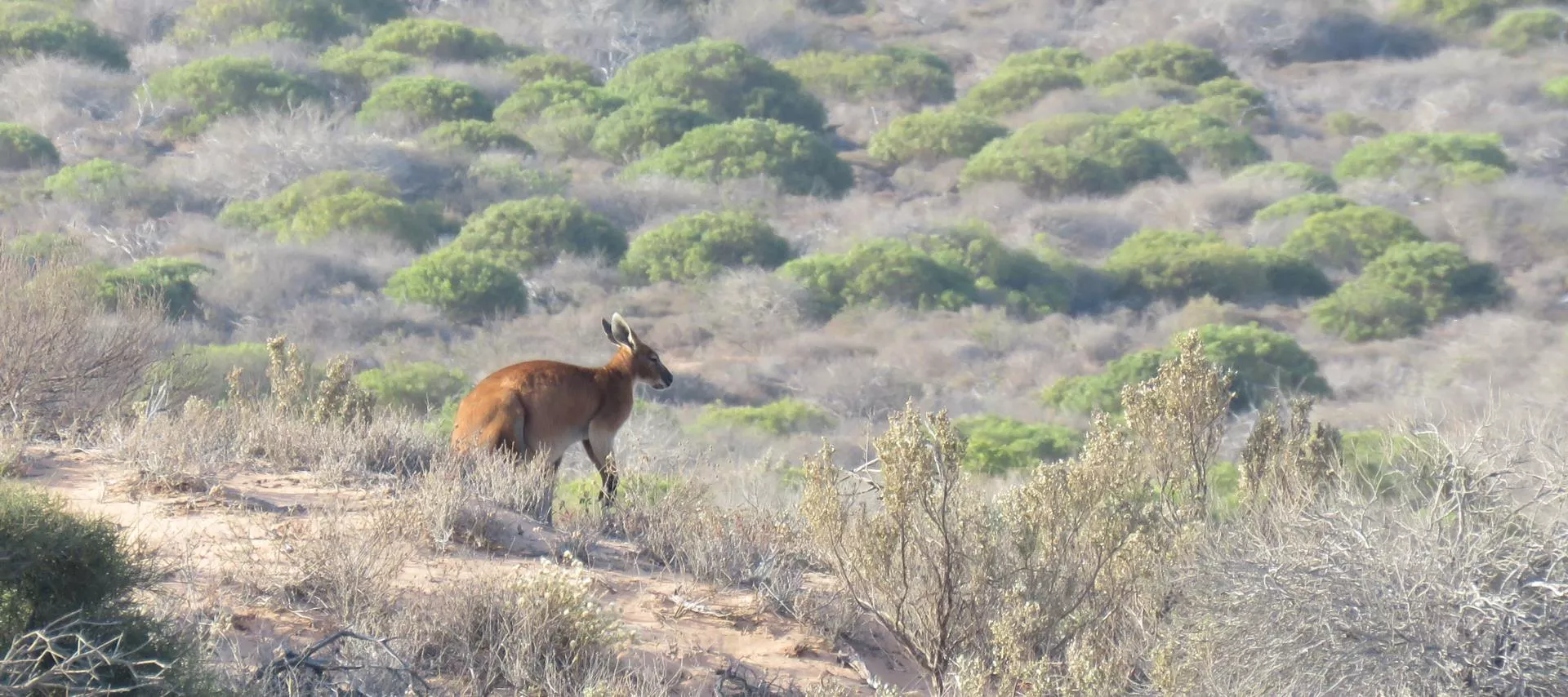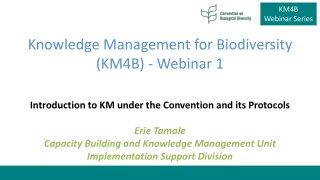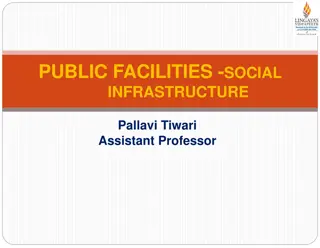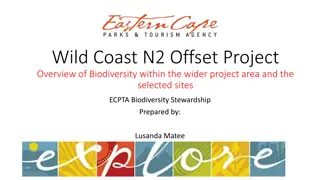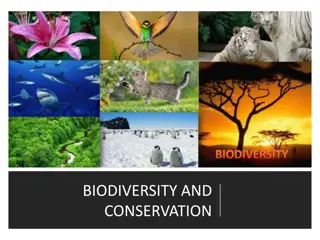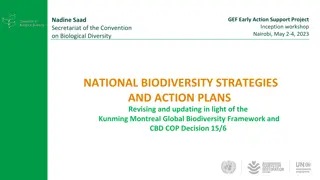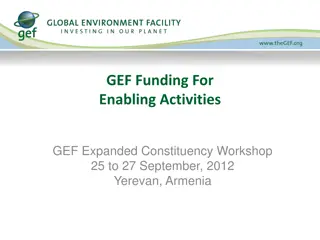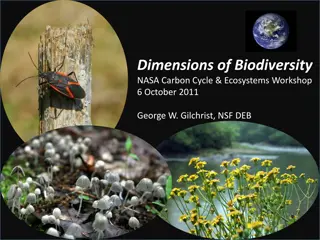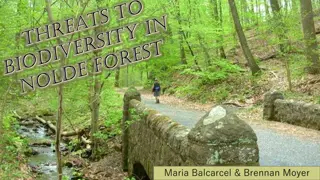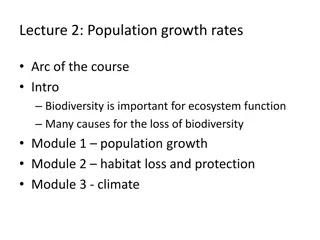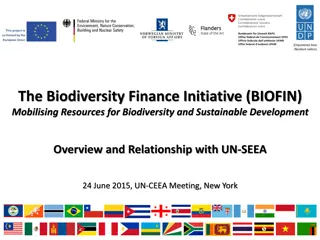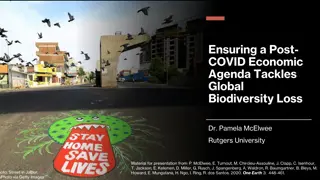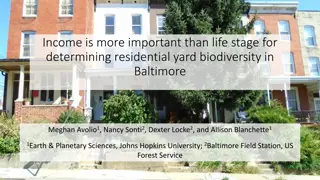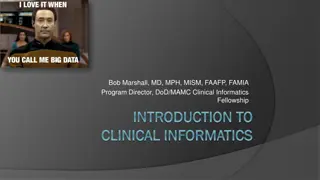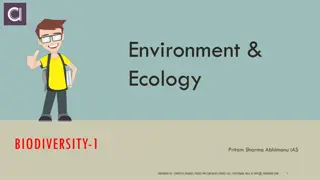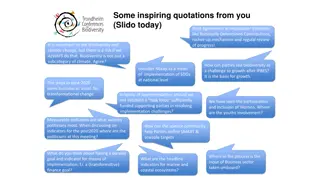Shared Challenges in Biodiversity Informatics Collaboration
The Coalition of Open Biodiversity Infrastructures and Networks aims to enhance collaboration for comprehensive biodiversity data management and accessibility. They focus on delivering biodiversity knowledge effectively, enabling stakeholder participation, promoting open data sharing, mobilizing historical data sources, and ensuring data preservation. Shared challenges include delivering biodiversity knowledge, enabling collaborative data curation, fostering interoperability, overcoming barriers to data sharing, addressing capacity needs, securing funding, and more.
Download Presentation

Please find below an Image/Link to download the presentation.
The content on the website is provided AS IS for your information and personal use only. It may not be sold, licensed, or shared on other websites without obtaining consent from the author.If you encounter any issues during the download, it is possible that the publisher has removed the file from their server.
You are allowed to download the files provided on this website for personal or commercial use, subject to the condition that they are used lawfully. All files are the property of their respective owners.
The content on the website is provided AS IS for your information and personal use only. It may not be sold, licensed, or shared on other websites without obtaining consent from the author.
E N D
Presentation Transcript
GBIC2 Closing session Donald Hobern, GBIF Executive Secretary Macropus robustus Gould, 1841, subspecies erubescens, Euro, Denham, WA, Australia, 10 January 2018
COALITION OF OPEN BIODIVERSITY INFRASTRUCTURES AND NETWORKS We are a network of infrastructures, institutions, agencies, societies and researchers which wish to collaborate more effectively to develop, adopt and promote models and approaches that support seamless and comprehensive generation, management and accessibility for information relating to all aspects of the world s biodiversity, at all scales and levels of organization, in multilingual forms and in ways that address the needs of all interested users and communities in all regions, and thereby to support the needs of science and society. http://biodiversityinformatics.org/
SHARED CHALLENGES 1 OF 3 1. To deliver biodiversity knowledge and understanding in forms which support critical research requirements and enable biodiversity to be correctly measured and valued for societal goals 2. To enable participation of all stakeholder groups in all regions as full collaborators at all stages from data generation to analysis and use 3. To remove barriers to free and open sharing of data and to adoption of FAIR principles for biodiversity data 4. To mobilise structured digital representations of historical data sources and to ensure new observations and measurements are born digital 5. To describe all data resources with rich metadata to support present and future reuse 6. To ensure all data resources are preserved in stable persistent repositories http://biodiversityinformatics.org/
SHARED CHALLENGES 2 OF 3 7. To enable collaborative curation, annotation and improvement of all data by any relevant expert communities 8. To enable different classes of biodiversity information (distribution, traits, genes, etc.) to be combined, queried and analysed together 9. To work with other research data infrastructures to achieve interoperability with earth-observing, social science and other resources 10. To track provenance and attribution for all sources of information 11. To enable all contributions of knowledge or expertise to be recorded, acknowledged and credited to the contributor 12. To ensure effective access and application of data at global, regional, national and local scales 13. To support the place of national and local investments as effective components within a global solution http://biodiversityinformatics.org/
SHARED CHALLENGES 3 OF 3 14. To overcome barriers to data sharing or use arising from language or culture 15. To address capacity needs around biodiversity informatics in all regions and in all sectors 16. To secure funding to maintain services and infrastructures recognised by the coalition as critical components within our digital ecosystem 17. To develop flexible collaborative approaches to designing, building and sustaining all components of our digital ecosystem 18. To enable stakeholders in every country and region to adopt and benefit from advances in infrastructure, tools, practices and capacity 19. To deliver robust and flexible solutions, appropriate for all stakeholders, for taxonomic and phylogenetic sharing, organization and access for data relating to any species http://biodiversityinformatics.org/
LIGHTWEIGHT COALITION All coalition partners will be equal stakeholders in developing vision and plans GBIF Secretariat will provide initial facilitation and support to: Develop and publicise paper outlining vision for coalition Establish mailing list and website for comments and for declarations of support Seek funding for initial tasks, workshops and engagements with other communities Need a suitable name should indicate clearly the lightweight intent Need to determine whether we should place any limits on individual or organisational declarations of support http://biodiversityinformatics.org/
INITIAL TASK 1 DEFINING QUESTIONS Should provide testable criteria for evaluating progress in delivering infrastructure Should be realistic and relate to real requirements Should include capability goals E.g. A knowledgeable taxonomist should be able to gain access directly to correct mistakes in handling of scientific names Should include exemplar research questions E.g. Is there a latitudinal signal in insect wing-lengths, and is it consistent across insect orders? Should include policy/societal questions E.g. Given existing land use and expected effects of climate change in the next 25 years, which of two possible configurations of protected areas and arable use areas is expected best to maximise survival of wild species currently found in the area? Should include questions to assess coverage and completeness E.g. Do existing data allow comparison between two time periods between the area of occupancy on a 5kmx5km grid for at least 75% of reptile species recorded from a region, at greater than 95% confidence? Consider having some extra questions for specific regions Can use coalition website/mailing lists to gather key questions Need to engage directly with key contributor and user communities to get their perspectives e.g. IAPT, CETAF, ICZN, IUCN, GEO BON, IPBES, CBD, selection of national and local initiatives Should develop a process for collecting, organising and refining questions Should include assessment of costs and benefits associated with supporting questions Divide responsibility between coalition members to work with each key contributor and user community to develop defining questions http://biodiversityinformatics.org/
INITIAL TASK 2 MAPPING NETWORK Develop landscape perspective of our major initiatives and their interrelationships with one another and key external stakeholders Understand dependencies and proximity or overlap First identify models and expertise to assist us with scoping, planning, designing and implementing this task Examples from RDA, European infrastructures, Colombia, etc. Questions of scope: Must include key stakeholders at international, regional and national levels Need to understand how much to include local and institutional stakeholders Need clear design (minimum sufficient content; semantic clarity; clear use for any documentation gathered; realistic planning for how to maintain the map this implies a narrower scope may be better) May be able and/or need to secure support from social scientists http://biodiversityinformatics.org/
FUTURE TASKS Use defining questions to develop overall architecture, identify critical components, and begin planning and/or incubation of missing components These steps will convene expert groups to steer consultation processes around major subdomains within our world GBIC2 has highlighted some of the benefits (as well as the challenges and frustrations) that come from bringing together a diverse pool of experts Explore patterns that will assist efficient roll-out of tools, practices and information delivery at national scales within the context of the global mosaic Consider adopting and expanding the Catalogue of Life Plus project as an early incubator activity Explore whether transition will be required for a long-term governance model and/or plan lifecycle or expected endpoint for coalition http://biodiversityinformatics.org/
HOW MUCH COORDINATION IS POSSIBLE? EASIER HARDER Shared vision Shared language Shared vision Shared language Shared priorities Shared vision Shared language Shared priorities Shared reporting Shared vision Shared language Shared priorities Shared reporting Shared funding Shared delivery Shared sustainability
STEERING COMMITTEE Brigitte Baptiste Rob Guralnick Donald Hobern GBIF Secretariat Denmark Eun Shik Kim KookminUniversity Korea Alexander von Humboldt Institute Colombia Florida Museum of Natural History USA Isayvani Naicker African Academy of Science Kenya Laetitia Navarro German Centre for Integrative BiodiversityResearch (iDiv) Germany Edwin van Huis Naturalis Netherlands
SESSION FACILITATORS Michelle Price Carolyn Sheffield Smithsonian Libraries USA John Wieczorek Melodie McGeoch Monash University Australia Conservatoire et Jardins Botaniques de Ville de Gen ve Switzerland University of California, Berkeley USA Dmitry Schigel GBIF Secretariat Denmark Daniel Noesgaard GBIF Secretariat Denmark Andrea Hahn GBIF Secretariat Denmark Andrew Rodrigues GBIF Secretariat Denmark







